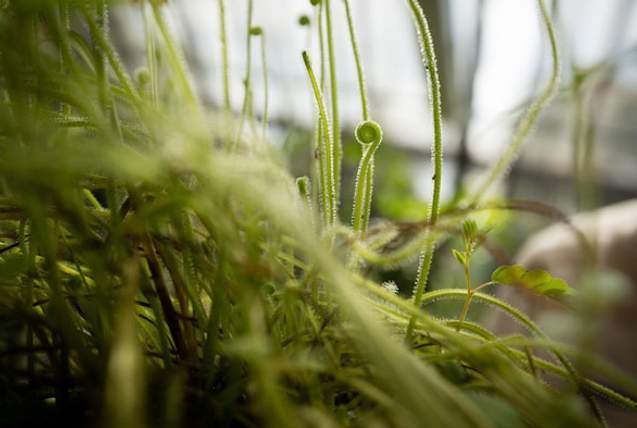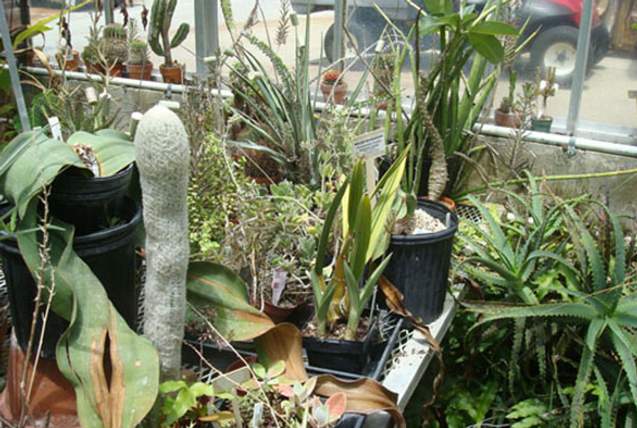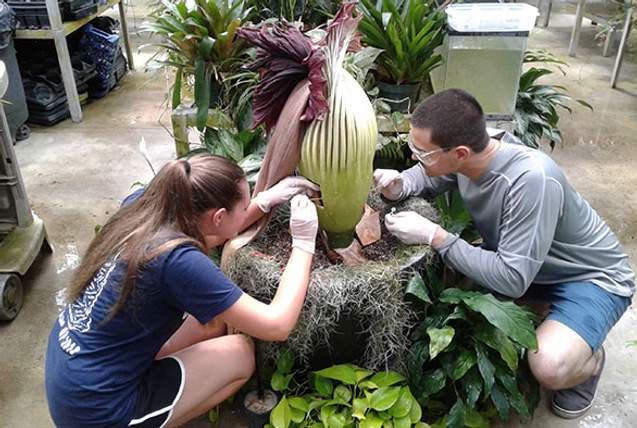
Greenhouse
Located atop the Bush Science Center, Rollins’ greenhouse is home to more than 800 species of plants and serves as an extension of the College’s science labs.
From orchids and herbs to the famously odd corpse plant, Rollins’ state-of-the-art greenhouse is home to hundreds of plant species from all around the world. The teaching collection contains a diverse assortment of plants needed to augment lectures and provide live lab specimens. The faculty and student research rooms will provide the space needed for ongoing faculty research and independent student research. Faculty and students can conduct experiments all year round using the environmental controls keeping temperatures, humidity, and light at their preferred optimum levels. The rooftop greenhouse gives an extraordinary opportunity for biology students to enhance their Rollins College learning experience.
Botanical Services
One of the services offered through the greenhouse is providing plant material for lab experiments or to augment class lectures and discussions in classes such as medicinal botany, genetics, biology, and field botany. The greenhouse also assists with ongoing research in areas such as the digestive enzymes in Nepenthes ventricosa ("Rooted, A Guide to the Lovely, Strange, and Notable Floras of Rollins") and the analysis of sun-tracking abilities in certain legume species. To accomplish these and other tasks, the botanical collection at the Greenhouse consists of representatives from many different plant families.
Greenhouse Plant Collection
The wide and diverse plant collection at the greenhouse is a delight to your sense of sight and smell. A visit will leave you wanting to add more plants to your personal plant collection. Some of the plants are very rare and hard to find. Come by and see for yourself!


Chocolate Tree
Native to Central and South America, Theobroma cacao is a small to medium-sized tree that prefers to grow in shady humid areas. The flowers bloom in clusters along the trunk that are pollinated by midges. The seeds are removed from the pods and through a fermentation process the cocoa is harvested from the seeds.

Ant Plant
Know as mutualism where both species benefit each other, Hydnophytum fornicarum provides domatia which are internal cavities that ants can inhabit. The ants in turn protect the plant from herbivores.

Tortoise Plant
Belonging to the yam family, Dioscorea mexicana produces an above-ground caudex that resembles a tortoise shell. The vine that comes from the center of the caudex needs a place to climb.
Florida Native Plants
Florida is a long state with several temperature zones and many types of ecosystems, including swamps, hardwood hammocks, and scrubs. Additionally, it has a wide range of weather patterns from wet hot summers, to dry cool late winters and springs. Native plants in Florida have evolved to withstand these conditions and thrive.

Florida Anise
A very attractive plant, Illicium floridanum prefers moist soil in a shady area. In the spring you will be rewarded with star-shaped purple-red flowers that are quite eye-catching.

Partridge Pea
Florida has an abundance of easy-to-grow native wildflowers such as the Partridge Pea, Chamaecrista fasciculata. Not only will the flowers attract adult butterflies, but it’s a host plant to several species of butterflies that will lay their eggs on them.

Coontie
A well-known Florida native, Zamia pumila is an easy-to-grow plant because once established it will survive on seasonal rains making it a good choice for a low-maintenance landscape.
Bromeliads
Many bromeliads are epiphytes or what is more commonly known as air plants. The epiphyte attaches itself to a host plant for support but does not take any nutrients from the host. Bromeliads thrive in bright light, which is why you will find them attached to tree branches. The tightly formed, rosette-shaped leaves will create a cup in the center of the plant which collects water that enables them to go for long periods without watering.

Tillandsia plants on cypress branch
Many Tillandsia are native to Florida. When hiking in hammocks and other heavily forested lands you can find them clinging to tree branches.

Silver vase
The flower of the Aechmea fasciata, a native of Brazil, will last for months. Even when not in bloom the striking leaves are very attractive.

Flaming sword
A very attractive plant, the Vriesea splendens is native to Eastern Venezuela and French Guiana. The beautifully stripped leaves are followed by an eye-catching, bight red inflorescence.
Carnivorous Plants
Found growing naturally in acidic, damp soils that are deficient in nutrients, carnivorous plants have evolved special adaptations that enable them to capture and digest insects to supplement their diet. To grow, not only does the acidic soil requirement need to be replicated, but the plants require high humidity and full sun. With a little effort, carnivorous plants add excitement to any plant collection.

Thread-leaf Sundew
Drosera filiformis, thread-leaf sundew, can be found growing in wet, marshy areas in the the northern part of Florida. The leaf is covered with tiny hairs each with a sticky drop of mucilage at the end ready to capture its prey.

Pitcher Plants
There are several Sarracenias species that are native to Florida such as S. Minor, S. purpurea, S. psittacina, and S. rubra. The funnel-shaped leaves trap insects and are digested by enzymes.

Tropical Pitcher Plants
The climbing stems of Nepenthes species produce modified leaves in the shape of a cup. These cups trap and digest insects by enzyme-producing glands at the bottom of them.
Cacti and Succulents
The literal meaning of succulents is "juicy plants." Many succulents and cacti are inhabitants of arid areas and have evolved the ability to store large amounts of water in their leaves, stems, and roots, hence the name. The interesting and grotesque forms make them quite appealing to the plant collector.

Table full of Succulents and Cacti
These arid-loving plants need a bright location with little water for them to thrive. Can you spot the the desert orchid? Yes, it's an orchid that grows in the desert! It's called Eulophia petersii and it is located toward the edge of the table.

Donkey's Tail Plant
Sedum morganianum can easily be propagated from leaves that readily break off from the stems. Native to Mexico, the blue-green leaves are very attractive and the pinkish flowers are a bonus.

Old Man Cactus
The hairs of the Cephalocereus senilis are modified spines that aid in protection from the sun and frost. In its native country of Mexico, the wool-like hairs are sometimes used in making sweaters.
Orchids
Many people think orchids are difficult to cultivate, but with the proper care, orchids can be quite easy to grow. Following a regime of good air movement, bright light, appropriate temperatures, proper watering and fertilizing techniques, and suitable growing medium, orchids will provide the grower with a gorgeous display of color for years to come.

Vanda Orchid
Vanda orchids have been highly hybridized and now come in a wide array of colors and sizes. Easy to grow, they need bright light and a very well-drained growing medium.

Dendrobium Orchids
A large genus, Dendrobium orchids are another easy group of orchids to grow. Like most orchids, many are epiphytes, air plants, that naturally cling to tree branches for better light.

Moth Orchid
Phalaenopsis orchids are probably the most popular of all the orchids because of their ease of growing and their extremely showy and large flowers. Native to tropical Asia, this orchid prefers a moist growing medium and bright light.
Rare and Exotic Plants
The Rollins College greenhouse is home to several and difficult-to-find exotic species.
Check out the 2016 edition of Ripley's Believe It or Not for a story on the 2015 corpse plant bloom.

Corpse Plant Corm
The Amorphophallus titanum corm, an underground stem used for food storage, weighed 35 pounds and was 16" in diameter at repotting time in August of 2014. Its first spectacular inflorescence opened during the early morning late hours of April 19, 2015.

Seeds of Corpse Plant
The Corpse Plant was pollinated during the early morning hours of April 20, 2015, and we were successful in our pollinating attempts. Each fruit contains one or two seeds that take several months to germinate.

Collecting Corpse Plant Pollen
Mia Brady '22 and Christian Kebbel '12 collect pollen from the recent (September of 2018) bloom of the Amorphophallus titanum. Using Q-tips the pollen is placed in small vials and stored in a -80 degree freezer until needed.
